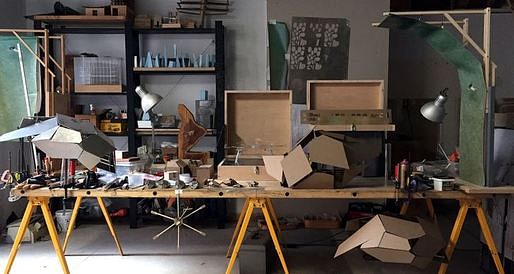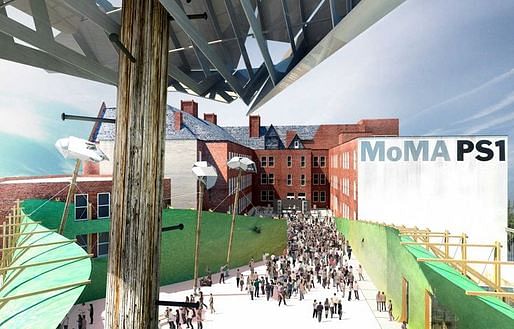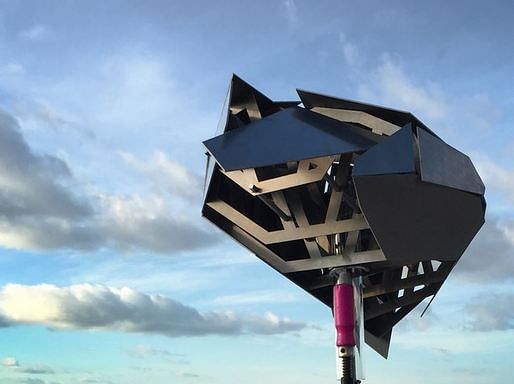

Photo by Brillhart Architecture - Model Shop
It's easy to forget that blog posts tend to be informal opinion based writing pieces that sometimes edge closely to the realm of narcissism. If this were a crime, I would most definitely be guilty. True, most of the work you find here on this blog is set specific to courses I teach and studies my students are working on, but I would like to think that I have also dedicated some writing to the interesting occurrences here at the University. Today I would like to focus on someone else’s work, a colleague of mine here named Jacob Brillhart.
Brillhart has been a faculty member at Miami for almost 10 years now, and during that span has managed to create a balance between academic life and private practice. His firm has won a variety of awards from local and state AIA chapters all the while carrying a full time credit teaching load at the school. You may be familiar with his work if you read the New York Times or the Architects Newspaper, as his recently built from scratch home was featured on both. Most recently, Brillhart was a finalist for the MoMA PS1 Young Architect’s Program. Although the proposal was not selected, I personally find the design quite interesting as it ties in regional aspects found in Miami with the latest technological trends. This is not a critique against the winning design by Andres Jacques, but rather as a platform to show work from a colleague and to show one of the other proposals for the PS1 space.
Below you will find an excerpt taken straight from Brillhart Architecture’s website, describing the project. There are also a variety of images and video explaining the project.
NARRARTIVE:
Photo by Brillhart Architecture -Drone's Beach
Rather than proposing a pure object or a skyscape or a landscape that could be inserted into the existing space, we were interested in transforming the space as a whole. Our proposal is a multi-sensory experience of a tropical beach that draws you into the depths of your imagination and allows you to escape the city.
As setting and atmosphere, the beach serves as a playground of limitless human experiences. When visitors come to this space, the sensational perceptions will all be entirely unique – shaped by different moods, cultural and personal situations, and past memories.

Photo by Brillhart Architecture -Architecture of the Drone
The project engages the existing infrastructure as an armature for design, beginning with reconstituting the concrete walls. Wooden ribs (which suggest the idea of vessel) increase the height and formal nature of the space while manipulating the vertical planes. The newly articulated surface is lined with evocative imagery and misting devices that create a “waterwomb.” The ground-plane has been transformed to suggest pure pink sand, while four “nest-infested” palm trees tower above the space. Associative smells function as instruments for memory and navigation, while the music from the DJ amplifies the experience.
Photo by Brillhart Architecture -New Vantage Points (Photo Credit of Actual Photographs used on the Walls: Richard Misrach)
Lastly, the project juxtaposes the narrative of escapism and contemporary public space. Embedded in the project is a certain inter-subjectivity between viewers, not only in the imagery that is used on the walls, but also with the incorporation of new media tools.

Photo by Brillhart Architecture -Palm Tree / Drones’ Nest View
With some ambiguity, the project speaks to the evolution of static urban environments into participatory and per formative social spaces. All the while, it offers new vantage points and multiple dimensions of reality.
Collaborators include photographer Richard Misrach and Berlin-based smell researcher, Sissel Tolaas.
Special Thanks to: Andrew Aquart; Stefani Fachini; James Harris; Ana Luiza Leite; Tom Makowski; Alfredo Socorro; Monica Socorro; Isaac Stein; and Jie Su; as well as Structural Engineer Gerry DeMarco; and Visualization Artist, Seiji Anderson (Renderbucket.com).
This blog gives a sneak peak into the architecture world at the University of Miami. What began as an experiment following one group of incoming graduate students through their first semester of design, has morphed into a window of the school of architecture through this professor's eyes. I will try to post as often as possible.
No Comments
Block this user
Are you sure you want to block this user and hide all related comments throughout the site?
Archinect
This is your first comment on Archinect. Your comment will be visible once approved.